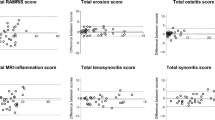Abstract
Objective. The authors assessed the MRI findings of appendicular coccidioidal arthritis. Design. T1- and T2-weighted MR images of affected joints, both with and without intravenous gadopentetate dimeglumine, were performed in nine adult patients (ten studies) and evaluated by three masted readers, using a four-point certainty scale for: synovial abnormality, articular cartilage loss, subarticular bone loss, abnormal marrow signal, enhancement of osseous and articular structures, and assessment of disease activity. Findings were correlated with biopsy results or clinical course. Results. Eight patients had active and one had inactive arthritis, involving the knee (five patients), ankle (two patients), and elbow (one patient). Synovial complex was the most common finding in active arthritis (P<0.025). Cartilage and subarticular bone loss were seen 56% and 89% of patients with active disease, respectively. Abnormal marrow signal was uncommon (two patients). All cases showed synovial and/or osseus enhancement. Conclusions. MRI findings in coccidiodal arthritis are described. Enhancement of thickened synovium and erosions was seen after intravenous gadopentetate.
Similar content being viewed by others
Author information
Authors and Affiliations
Rights and permissions
About this article
Cite this article
Lund, P., Chan, K., Unger, E. et al. Magnetic resonance imaging in coccidioidal arthritis. Skeletal Radiol 25, 661–665 (1996). https://doi.org/10.1007/s002560050154
Issue Date:
DOI: https://doi.org/10.1007/s002560050154




